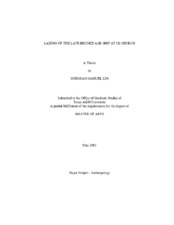| dc.description.abstract | The Uluburun shipwreck was discovered in 1982 when a Turkish sponge diver informed the Institute of Nautical Archaeology (INA) of his discovery of metal biscuits with ears. INA archaeologists recognized this as a description of oxhide ingots, a clear indication of a Late Bronze Age site. This find was of considerable interest as very little is known about seafaring, long distance trade, and ship construction during the Late Bronze Age, except for a glimpse provided by the Cape Gelidonya shipwreck excavated in 1960 by George Bass. The site at Uluburun revealed only a handful of disarticulated ship fragments; nevertheless, a meticulous study of these timbers and the distribution of the cargo and shipboard items on the seabed resulted in a hypothetical, but carefully guided, reconstruction of the ship and the lading of its cargo. The artifacts recovered from the Uluburun shipwreck are unlike those discovered on land in quality of preservation as well as the quantity found. Items pertinent to this study include 354 copper oxhide ingots (approximately 10 tons), 152 copper bun ingots (nearly 1 ton), 110 tin ingot fragments (approximately 1 ton), 175 glass ingots (approximately 0.3 tons), 150 Canaanite jars (approximately 2 tons if filled with water), 10 large storage jars (pithoi) (approximately 3.5 tons if filled with water), approximately 51 Canaanite pilgrim flasks, 24 stone anchors (3.3 tons), nearly 1 ton of ballast stones, and the hull remains itself. Two computer programs, Rhinoceros and PHASER, were used to visually model the artifacts and ship in three-dimensions and to systematically test various hull shapes and lading arrangements in a range of hydrostatic conditions. Tests showed that a hull measuring 15 x 5 x 2 m would be capable of carrying the estimated 20 tons of cargo and shipboard items recovered from the wreck at a draft of 1 m, with sufficient freeboard to allow six passengers to stand on one side of the vessel without compromising the stability of the ship. | en |


